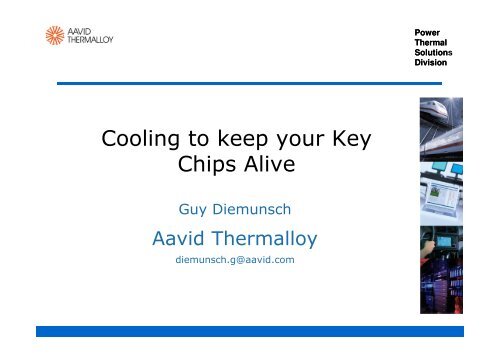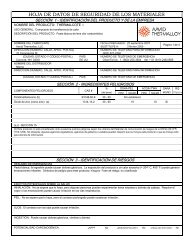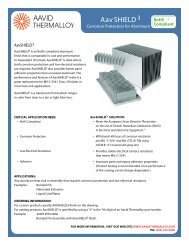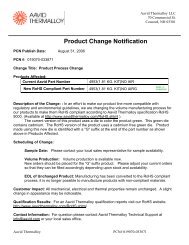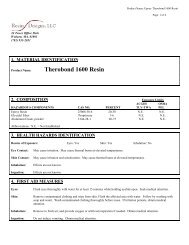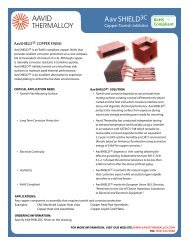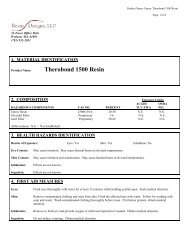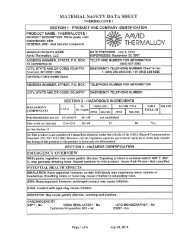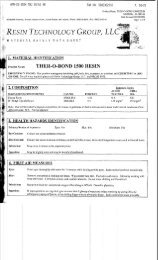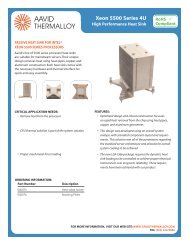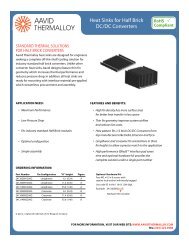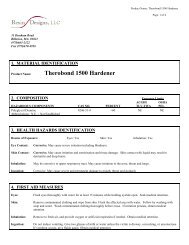You also want an ePaper? Increase the reach of your titles
YUMPU automatically turns print PDFs into web optimized ePapers that Google loves.
Cooling to keep your Key<br />
Chips Alive<br />
Guy Diemunsch<br />
<strong>Aavid</strong> Thermalloy<br />
diemunsch.g@aavid.com<br />
Power<br />
Thermal<br />
Solution Solutions<br />
Division
Agenda<br />
� From the Chip to the Fluid<br />
� The story of conductivity and heat density<br />
� Technologies and <strong>Heat</strong> Transfer coefficients<br />
� Automotive Constrains<br />
� Solutions<br />
� Balancing Chips Temperatures<br />
� Mass Flow Rate or Latent <strong>Heat</strong><br />
� Solutions<br />
� Emergency situations<br />
� Can we store heat?<br />
� Solutions<br />
Power<br />
Thermal<br />
Solution Solutions<br />
Division<br />
04 / 04 / 2011 Rev. 1.1 Guy Diemunsch<br />
2
From the Chip to the Fluid<br />
� Straightforward point of view<br />
� In a car the only available cold source is the<br />
surrounding air<br />
� P [W] = H [W/m² °C] S [m²] ∆ Tsolid/Tfluid [°C]<br />
� The surface of the heat exchanger with surrounding<br />
air is mainly defined by the power to extract<br />
� The volume of the heat exchanger is generating<br />
the pressure drop : smaller size => higher<br />
pressure drop!<br />
Power<br />
Thermal<br />
Solution Solutions<br />
Division<br />
04 / 04 / 2011 Rev. 1.1 Guy Diemunsch<br />
3
� Conductivity & <strong>Heat</strong> density<br />
� Simple rules !<br />
From the Chip to the Fluid<br />
CHIP DCB<br />
<strong>Heat</strong> Spreader<br />
Thermal Interface<br />
<strong>Heat</strong> <strong>sink</strong> <strong>base</strong><br />
Power<br />
Thermal<br />
Solution Solutions<br />
Division<br />
04 / 04 / 2011 Rev. 1.1 Guy Diemunsch<br />
4
� Conductivity & <strong>Heat</strong> density<br />
� Simple rules !<br />
From the Chip to the Fluid<br />
CHIP DCB<br />
<strong>Heat</strong> Spreader<br />
Thermal Interface<br />
<strong>Heat</strong> <strong>sink</strong> <strong>base</strong><br />
� The heat is lazy, always searching the easiest way<br />
which is a combination of distance and resistance<br />
Power<br />
Thermal<br />
Solution Solutions<br />
Division<br />
04 / 04 / 2011 Rev. 1.1 Guy Diemunsch<br />
5
From the Chip to the Fluid<br />
� Conductivity & <strong>Heat</strong> density<br />
� Simple rules !<br />
CHIP DCB<br />
<strong>Heat</strong> Spreader<br />
Thermal Interface<br />
� Conductivity increases heat spreading<br />
� Thickness increases heat spreading<br />
� <strong>Heat</strong> density decreases<br />
<strong>Heat</strong> <strong>sink</strong> <strong>base</strong><br />
Power<br />
Thermal<br />
Solution Solutions<br />
Division<br />
04 / 04 / 2011 Rev. 1.1 Guy Diemunsch<br />
6
From the Chip to the Fluid<br />
� Conductivity & <strong>Heat</strong> density<br />
� When the cold source is small:<br />
CHIP DCB<br />
<strong>Heat</strong> Spreader<br />
Thermal Interface<br />
Pipe or heat pipe<br />
<strong>Heat</strong> <strong>sink</strong> <strong>base</strong><br />
� The heat density may remain stable or may<br />
increase!<br />
� Thermal Interfaces are more critical<br />
� <strong>Heat</strong> Transfer Coefficient must increase<br />
Power<br />
Thermal<br />
Solution Solutions<br />
Division<br />
04 / 04 / 2011 Rev. 1.1 Guy Diemunsch<br />
7
From the Chip to the Fluid<br />
� Reducing Chip temperature &/or increasing<br />
∆ Tsolid/Tfluid<br />
Temperature<br />
spreader <strong>base</strong><br />
chip Interface<br />
Power<br />
fins air<br />
Interface<br />
Power and temperature evolution from the chip to the fluid<br />
Power<br />
Thermal<br />
Solution Solutions<br />
Division<br />
04 / 04 / 2011 Rev. 1.1 Guy Diemunsch<br />
8
� Reducing Chip temperature &/or increasing<br />
∆ Tsolid/Tfluid<br />
Objective A:<br />
reduce chip temperature<br />
From the Chip to the Fluid<br />
Temperature<br />
peltier<br />
spreader<br />
chip Interface<br />
<strong>base</strong> fins<br />
Interface<br />
air<br />
Interface<br />
Consequences:<br />
increase these ∆T’s<br />
Power<br />
Objective B:<br />
increase this ∆T<br />
Power and temperature evolution from the chip to the fluid<br />
with a Peltier Cell<br />
Power<br />
Thermal<br />
Solution Solutions<br />
Division<br />
04 / 04 / 2011 Rev. 1.1 Guy Diemunsch<br />
9
From the Chip to the Fluid<br />
� Technologies and <strong>Heat</strong> Transfer coefficients<br />
From Electronics Cooling<br />
Power<br />
Thermal<br />
Solution Solutions<br />
Division<br />
04 / 04 / 2011 Rev. 1.1 Guy Diemunsch<br />
10
From the Chip to the Fluid<br />
� Technologies and <strong>Heat</strong> Transfer coefficients<br />
From Electronics Cooling<br />
Flow H (W/m².°C)<br />
Air: natural convection 5 – 30<br />
Air: forced convection 20 – 200<br />
Air: jet impingement 200 – 900<br />
Water: natural convection 30 – 300<br />
Water: forced convection 300 - 8.000<br />
Water: jet impingement 8.000 - 50.000<br />
Boiling water 2.000 - 100.000<br />
Noisy!<br />
Thermo Syphon<br />
<strong>Heat</strong> pipes<br />
Power<br />
Thermal<br />
Solution Solutions<br />
Division<br />
04 / 04 / 2011 Rev. 1.1 Guy Diemunsch<br />
11
From the Chip to the Fluid<br />
� Preliminary conclusion<br />
� It is often needed to spread the heat before<br />
moving it into a fluid<br />
� Some space is needed to allow this spreading =><br />
constrain on electronic design<br />
� Closer to the chip we are, less possibilities we have<br />
� Jet impingement and heat pipe become rapidly a<br />
must<br />
Power<br />
Thermal<br />
Solution Solutions<br />
Division<br />
04 / 04 / 2011 Rev. 1.1 Guy Diemunsch<br />
12
From the Chip to the Fluid<br />
� Automotive Constrains<br />
� Once again at the end we have to transfer the heat<br />
to the air => 2nd worst heat transfer coefficient:<br />
forced convection<br />
� Therefore all other solutions are only used to transfer<br />
the heat to the heat exchanger<br />
� The air is dirty => Clogging does not allow high<br />
density fins without maintenance<br />
� In Hybrid vehicles the water might be hot => high<br />
density fins required (low ∆ T)<br />
� … dirty => high density fins in water may not be<br />
welcome (clogging)<br />
Power<br />
Thermal<br />
Solution Solutions<br />
Division<br />
04 / 04 / 2011 Rev. 1.1 Guy Diemunsch<br />
13
� Solutions:<br />
From the Chip to the Fluid<br />
� <strong>Heat</strong> Pipe are the best solution to catch efficiently<br />
high heat density very close to the chip<br />
Power<br />
Thermal<br />
Solution Solutions<br />
Division<br />
04 / 04 / 2011 Rev. 1.1 Guy Diemunsch<br />
14
From the Chip to the Fluid<br />
� Drawback:<br />
� High constrains on the thermal interfaces (chip to<br />
evaporator block, evaporator block to <strong>Heat</strong> Pipe)<br />
Power<br />
Thermal<br />
Solution Solutions<br />
Division<br />
04 / 04 / 2011 Rev. 1.1 Guy Diemunsch<br />
15
From the Chip to the Fluid<br />
� Drawback:<br />
� High constrains on the thermal interfaces is<br />
improved by direct contact<br />
Power<br />
Thermal<br />
Solution Solutions<br />
Division<br />
04 / 04 / 2011 Rev. 1.1 Guy Diemunsch<br />
16
From the Chip to the Fluid<br />
� Limited distance between heat source and heat<br />
exchanger (< 1m)<br />
� Start up difficult<br />
� Need special heat pipe for low temperatures (<<br />
0°C)<br />
Power<br />
Thermal<br />
Solution Solutions<br />
Division<br />
04 / 04 / 2011 Rev. 1.1 Guy Diemunsch<br />
17
From the Chip to the Fluid<br />
� LCP’s including offset fins are a lot more efficient<br />
than LCP’s using pipes they allow heat spreading<br />
with high heat exchange surfaces<br />
� Risk of clogging<br />
Power<br />
Thermal<br />
Solution Solutions<br />
Division<br />
04 / 04 / 2011 Rev. 1.1 Guy Diemunsch<br />
18
From the Chip to the Fluid<br />
� Direct jet impingement cooling overcomes the<br />
clogging constrains and is compatible with hot<br />
water<br />
� Less available surface<br />
Component heat<br />
spreader<br />
Nozzles<br />
From Electronics Cooling<br />
� Chip position constrains to make an efficient Jet<br />
impingement solution<br />
Power<br />
Thermal<br />
Solution Solutions<br />
Division<br />
04 / 04 / 2011 Rev. 1.1 Guy Diemunsch<br />
19
From the Chip to the Fluid<br />
� The current water to air heat exchanger is quite<br />
perfect it has to be duplicated<br />
From Schneider Electric<br />
Power<br />
Thermal<br />
Solution Solutions<br />
Division<br />
04 / 04 / 2011 Rev. 1.1 Guy Diemunsch<br />
20
Agenda<br />
� From the Chip to the Fluid<br />
� The story of conductivity and heat density<br />
� Technologies and <strong>Heat</strong> Transfer coefficients<br />
� Automotive Constrains<br />
� Solutions<br />
� Balancing Chips Temperatures<br />
� Mass Flow Rate or Latent <strong>Heat</strong><br />
� Solutions<br />
� Emergency situations<br />
� Can we store heat?<br />
� Solutions<br />
Power<br />
Thermal<br />
Solution Solutions<br />
Division<br />
04 / 04 / 2011 Rev. 1.1 Guy Diemunsch<br />
21
Balancing<br />
Chips Temperatures<br />
� When we have multiple chips working<br />
together it is important, to balance loads an<br />
improve efficiency, that each kind of chip has<br />
the “same” temperature<br />
� Because we use a mass flow to cool the ideal<br />
solution is that all components are // vs the<br />
flow<br />
CHIP A1 CHIP B1 CHIP A2 CHIP B2<br />
Power<br />
Thermal<br />
Solution Solutions<br />
Division<br />
04 / 04 / 2011 Rev. 1.1 Guy Diemunsch<br />
22
Balancing<br />
Chips Temperatures<br />
� However it often impossible to do!<br />
� Management of the Mass flow rate (air or<br />
liquid)<br />
CHIP A1 CHIP B1 CHIP A2 CHIP B2<br />
� P [J/s] = H c [J/kg °C] M [kg/s] ∆ t [°C]<br />
� M = P / H c (0,5 or 1,5 or 3)<br />
(H c: <strong>Heat</strong> Capacity)<br />
Power<br />
Thermal<br />
Solution Solutions<br />
Division<br />
04 / 04 / 2011 Rev. 1.1 Guy Diemunsch<br />
23
� Latent <strong>Heat</strong><br />
Balancing<br />
Chips Temperatures<br />
� When the phase change occurs the temperature is<br />
fixed and stable<br />
Power<br />
Thermal<br />
Solution Solutions<br />
Division<br />
04 / 04 / 2011 Rev. 1.1 Guy Diemunsch<br />
24
� Solutions:<br />
Balancing<br />
Chips Temperatures<br />
� Latent heat: heat pipe (or hp loop, vapor chamber)<br />
From Schneider Electric<br />
Power<br />
Thermal<br />
Solution Solutions<br />
Division<br />
04 / 04 / 2011 Rev. 1.1 Guy Diemunsch<br />
25
� Solutions:<br />
Balancing<br />
Chips Temperatures<br />
� Jet impingement allows to recreate a // cooling<br />
Power<br />
Thermal<br />
Solution Solutions<br />
Division<br />
04 / 04 / 2011 Rev. 1.1 Guy Diemunsch<br />
26
� Solutions:<br />
Balancing<br />
Chips Temperatures<br />
� Fin density variation (air)<br />
� Incompatible with low cost extrusions<br />
Power<br />
Thermal<br />
Solution Solutions<br />
Division<br />
04 / 04 / 2011 Rev. 1.1 Guy Diemunsch<br />
27
� Solutions:<br />
Balancing<br />
Chips Temperatures<br />
� Fin density variation (liquid)<br />
Power<br />
Thermal<br />
Solution Solutions<br />
Division<br />
04 / 04 / 2011 Rev. 1.1 Guy Diemunsch<br />
28
Agenda<br />
� From the Chip to the Fluid<br />
� The story of conductivity and heat density<br />
� Technologies and <strong>Heat</strong> Transfer coefficients<br />
� Automotive Constrains<br />
� Solutions<br />
� Balancing Chips Temperatures<br />
� Mass Flow Rate or Latent <strong>Heat</strong><br />
� Solutions<br />
� Emergency situations<br />
� Can we store heat?<br />
� Solutions<br />
Power<br />
Thermal<br />
Solution Solutions<br />
Division<br />
04 / 04 / 2011 Rev. 1.1 Guy Diemunsch<br />
29
Emergency situations<br />
� What is an emergency situation?<br />
� As soon as a component of the cooling chain fails<br />
we face an emergency situation<br />
TIM<br />
<strong>Heat</strong><br />
Transfer<br />
<strong>Heat</strong><br />
exchange<br />
Air<br />
(forced)<br />
� Closer to the chip the failure is, higher the<br />
emergency is<br />
Power<br />
Thermal<br />
Solution Solutions<br />
Division<br />
04 / 04 / 2011 Rev. 1.1 Guy Diemunsch<br />
30
� Can we store heat?<br />
Emergency situations<br />
� Yes, the two possible functions able to store heat<br />
might be:<br />
TIM<br />
<strong>Heat</strong><br />
Transfer<br />
� However it is theory:<br />
<strong>Heat</strong><br />
exchange<br />
Air<br />
(forced)<br />
� the air is available, we just have to insure that it is<br />
always moving<br />
� in most of the cases the components are designed to<br />
be fully loaded by heat and the system works as a<br />
serial assembly<br />
Power<br />
Thermal<br />
Solution Solutions<br />
Division<br />
04 / 04 / 2011 Rev. 1.1 Guy Diemunsch<br />
31
� Solutions:<br />
� No TIM<br />
Emergency situations<br />
� Direct liquid/dual phase cooling<br />
� Mechanical high performance TIM<br />
� Mirror surface<br />
� High pressure mechanical assemblies<br />
� Welding, Soldering, Brazing<br />
Power<br />
Thermal<br />
Solution Solutions<br />
Division<br />
04 / 04 / 2011 Rev. 1.1 Guy Diemunsch<br />
32
Emergency situations<br />
� Use liquid transfer designed with storage capacities<br />
� High volume of liquid<br />
� Higher mass flow rate<br />
� Implement backup <strong>Heat</strong> Pipes<br />
Anyway this will result with margin in R th<br />
� Always allow natural convection and use as much<br />
as possible the movement of the car to generate<br />
backup forced convection<br />
Power<br />
Thermal<br />
Solution Solutions<br />
Division<br />
04 / 04 / 2011 Rev. 1.1 Guy Diemunsch<br />
33


